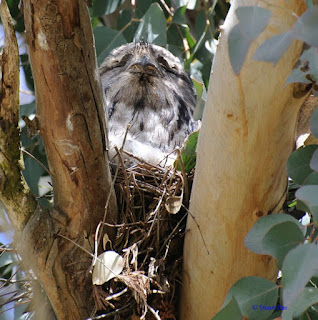
The frogmouth chicks are quite large now, although they are slow-growing. Most are about four weeks old and ready to leave the nest.
These chicks are typically lying quietly in the nest while the adult male keeps watch from farther along the branch.

The chicks are still partly downy and can only fly short distances. This chick has flown to the next branch from its nest, where its sibling was still with the male. The female meanwhile stands guard over this fledgling.

Two days after leaving the nest this chick was about seventy metres from the nest. Although they can be regarded as fledglings at this stage because they have left the nest. They are still much smaller than the adult birds and weak fliers. They are more aptly described as branchers.
Their tails are still short and wing feathers rather stumpy. The bristle feathers on their forehead have developed well though, and these help to conceal them when they instinctively adopt their head-erect concealment pose.





